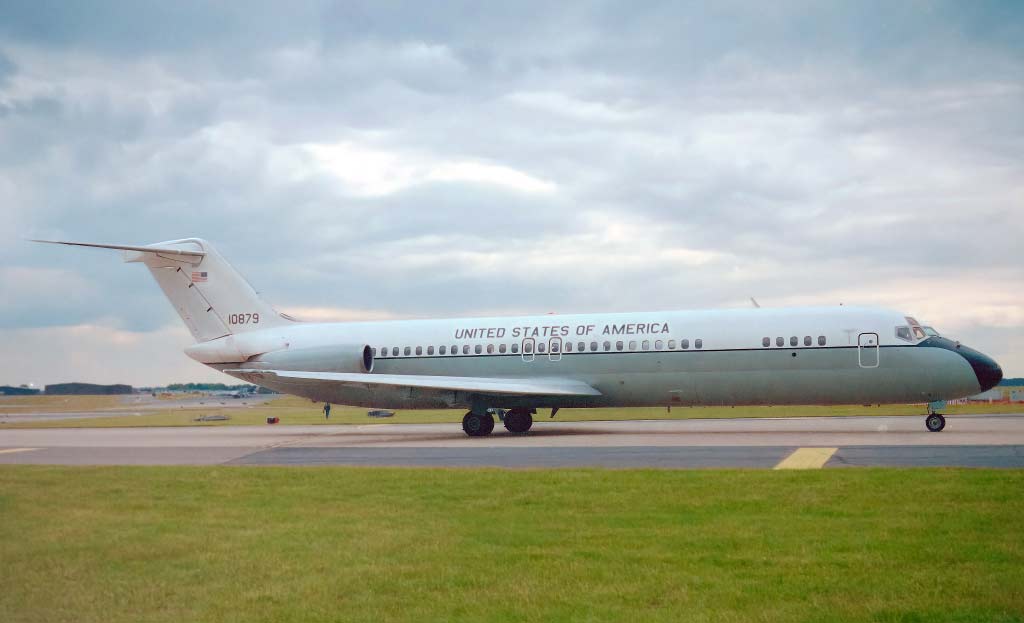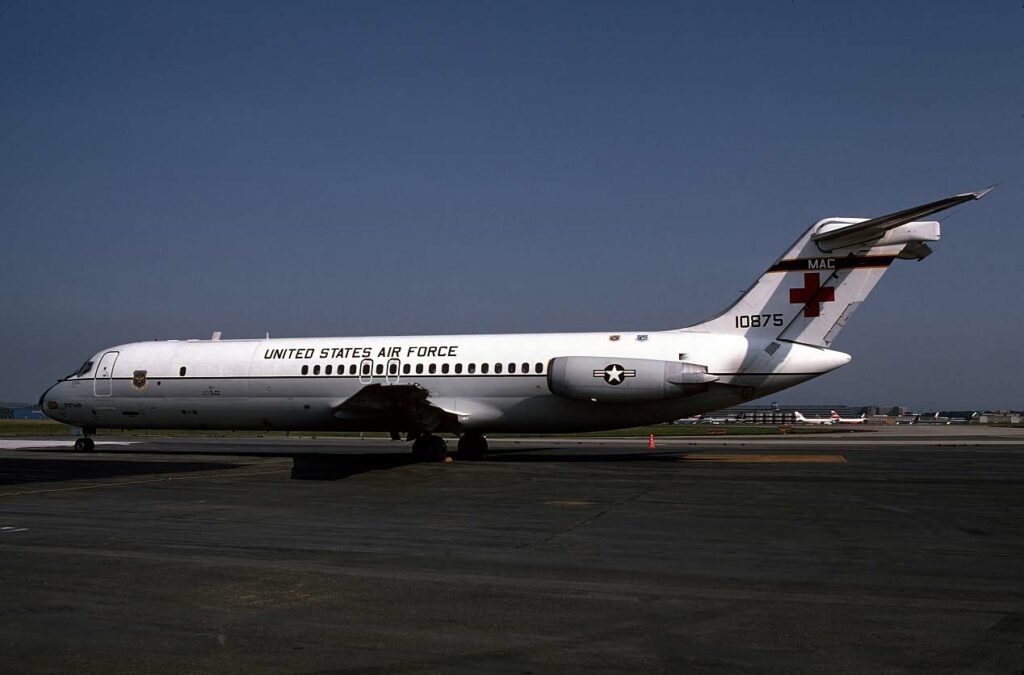The C-9 is a military adaptation of the DC-9, serving primarily in medevac and transport roles.
In brief
The McDonnell Douglas C-9 Nightingale/Skytrain II, a military version of the commercial DC-9 jetliner, was tailored for medevac, passenger transport, and logistical support. It features a high-wing, twin-engine design optimal for short to medium-haul flights. The C-9 accommodates a range of military duties, distinguished by its adaptability and efficiency in rapid aeromedical evacuation and transport, showcasing pressurized cabins, extensive medical equipment, and capacity for stretcher and ambulatory patients.

History of the Development of the McDonnell Douglas C-9 (Nightingale/Skytrain II)
The McDonnell Douglas C-9 Nightingale/Skytrain II emerged during a period when the U.S. military recognized the growing necessity for a specialized aircraft dedicated to aeromedical evacuations and versatile cargo transportation. This need was particularly underscored by the Vietnam War’s demands, highlighting the limitations of then-existing medevac platforms.
The development program was initiated by the U.S. Air Force in the late 1960s, seeking a jet-powered aircraft to ensure rapid, reliable, and efficient transportation of wounded personnel, aligning with the increasing velocity of military logistics and medical response. The choice to adapt the McDonnell Douglas DC-9 airliner for this role was driven by its proven performance in commercial aviation, offering the ideal blend of speed, range, and airlift capacity.
The C-9A Nightingale, the initial variant specifically designed for the aeromedical evacuation role, first flew on 18 February 1968. This aircraft was uniquely outfitted to accommodate intensive medical missions, becoming the first jet specifically designed and built for this purpose in the U.S. Air Force. Its design was a direct response to the operational exigencies observed during Vietnam, aiming to significantly reduce the time required to transport critically injured personnel to definitive care facilities.
While the C-9 didn’t have a specific NATO nickname, its operational roles and missions were clearly defined within U.S. military and NATO logistics frameworks. The aircraft’s development mirrored the evolving nature of military medical evacuation, embodying advancements in aerospace technology and aeromedical practices.
Design of the McDonnell Douglas C-9 (Nightingale/Skytrain II)
The design of the McDonnell Douglas C-9 reflects a strategic modification of the commercial DC-9 jetliner to meet specific military requirements. It retains the DC-9’s twin-engine, T-tail configuration but is equipped with features tailored for medevac and cargo duties.
Structurally, the C-9 includes a pressurized cabin that can be rapidly reconfigured for various missions, ranging from carrying cargo to accommodating stretchers and medical staff. The aircraft is fitted with large cargo doors, built-in airstairs, and advanced life-support equipment, making it well-suited for its primary role in aeromedical evacuations.
The aircraft’s dimensions, with a wingspan of 89 feet 5 inches (27.25 meters) and a length of 119 feet 3 inches (36.37 meters), along with a maximum takeoff weight of approximately 108,000 pounds (49,000 kilograms), illustrate its medium-sized airlift capacity. The cabin layout is optimized for versatility, capable of carrying up to 40 patients or 75 personnel, depending on the seating configuration.
Advantages of the C-9 include its rapid response capability, operational efficiency, and adaptability to diverse mission requirements. However, the aircraft’s reliance on traditional turbofan engines and design constraints inherited from the commercial DC-9 meant it was less suited for rough-field operations compared to cargo aircraft with turboprop engines or rugged airframes.
Performance of the McDonnell Douglas C-9 (Nightingale/Skytrain II)
The C-9 Nightingale/Skytrain II is powered by two Pratt & Whitney JT8D-9A turbofan engines, each providing 14,500 pounds of thrust, enabling a cruising speed of 565 mph (910 km/h) and a range of up to 2,560 miles (4,120 kilometers). Its service ceiling is 37,000 feet (11,280 meters), allowing for high-altitude operations to avoid adverse weather and potential ground threats.
In comparing the C-9 to contemporaneous military transport aircraft, its performance is notable for a jet-powered medevac role. While it does not possess the short takeoff and landing capabilities of some turboprop transports, its speed, altitude capability, and pressurized cabin offer significant advantages in rapid medical evacuation and personnel transport missions, ensuring quick and efficient patient transfer over long distances.
The aircraft’s design and performance metrics were specifically tailored to fulfill a niche within military operations, bridging the gap between large cargo airlifters and smaller, less capable medevac platforms. Its operational efficiency is particularly evident when compared to older propeller-driven aircraft, providing a faster, more reliable, and comfortable means of transportation, crucial for time-sensitive medical and logistical missions.
The C-9’s jet speed significantly reduced the time to transport patients from remote locations to advanced medical facilities, a critical factor in medical outcomes during emergencies. Its operational range and speed also enabled the U.S. military to extend its medical evacuation and transport capabilities across larger operational theaters, enhancing rapid response and strategic flexibility.
Variants of the McDonnell Douglas C-9 (Nightingale/Skytrain II)
The C-9 aircraft family includes several variants, each tailored to specific operational needs:
- C-9A Nightingale: Specifically designed for the U.S. Air Force for aeromedical evacuation, this variant featured advanced life-support systems, capacity for stretchers, and medical personnel, optimized for patient care in flight.
- C-9B Skytrain II: Utilized by the U.S. Navy and Marine Corps for cargo transport, personnel transport, and fleet logistical support. This variant offered flexibility in carrying mixed cargo and passenger loads, supporting naval operations worldwide.
- VC-9C: This variant was used primarily for VIP transport, including the transportation of senior government and Department of Defense officials. It featured accommodations for distinguished passengers with enhanced communication and comfort features.
Each variant of the C-9 reflected specific adaptations of the base DC-9 design, catering to the diverse requirements of military logistics, medical evacuation, and VIP transport, demonstrating the platform’s versatility and adaptability to various mission profiles.

Military Use and Combat of the McDonnell Douglas C-9 (Nightingale/Skytrain II)
The C-9 Nightingale/Skytrain II’s primary role in military operations was not direct combat but rather crucial support in medical evacuations, logistical transport, and VIP carriage. Its deployment in conflict zones, however, was integral to operational success, providing indispensable capabilities in rapid medical evacuation and strategic mobility.
Throughout its service life, the C-9 played a pivotal role in numerous military operations and humanitarian missions. Its speed and range were crucial in operations such as Desert Storm and Iraqi Freedom, where rapid medical evacuation from combat zones to hospitals in Europe or the United States significantly increased survival rates of wounded service members.
The aircraft was also involved in humanitarian missions, including disaster response and medical relief operations, where its capabilities were used to transport medical supplies, relief workers, and evacuate casualties from disaster-stricken areas.
Comparatively, while the C-9 did not carry armaments or participate in direct combat, its value in enhancing operational effectiveness and saving lives is immeasurable. It complemented other military aircraft by fulfilling a niche role that combined the speed of a jet transport with the functionality of a mobile hospital and logistics platform.
The C-9’s significance extends to its contribution to strategic mobility, enabling the U.S. military to project power and execute rapid-response operations globally. Its operational record demonstrates a reliable and effective service life, contributing significantly to the U.S. military’s air mobility and aeromedical evacuation capabilities.
As military requirements evolved and newer technologies emerged, the C-9 fleet was eventually phased out, replaced by more modern platforms like the C-17 Globemaster and C-130J Super Hercules, which offer enhanced capabilities, including the ability to operate in more austere environments, carry larger payloads, and perform a wider range of missions.
The McDonnell Douglas C-9 Nightingale/Skytrain II distinguished itself as a versatile and reliable aircraft, adept in fulfilling the specific needs of medical evacuation, personnel transport, and logistical support for the U.S. military. Its adaptation from the commercial DC-9 airliner to a specialized military configuration demonstrates a successful application of civil aviation technology for military purposes. The aircraft’s operational history underscores its significant contributions to military medical care, logistical operations, and humanitarian missions, marking its legacy as an essential component of military aviation and aeromedical evacuation history.
Back to Transport planes.